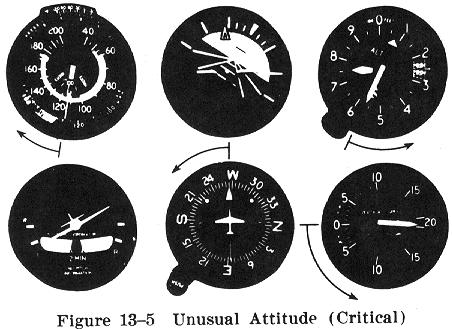
When outside visual references are inadequate or lost, the VFR pilot is apt to unintentionally let the airplane enter a critical attitude (sometimes called an "unusual attitude"). In general, this involves an excessively nose high attitude in which the airplane may be approaching a stall, or an extremely steep bank which may result in a steep downward spiral.
Since such attitudes are not intentional, they are often unexpected, and the reaction of an inexperienced or inadequately trained pilot is usually instinctive rather than intelligent and deliberate. However, with practice, the techniques for rapid and safe recovery from these critical attitudes can be learned.
During dual instruction flights, the pilot should be instructed to take the hands and feet off the controls and to close the eyes. The airplane then should be put into a critical attitude by the instructor. The attitude may be an approach to a stall, or a well developed spiral dive. At this point, the pilot should be told to open the eyes, take the controls and effect a recovery by reference to flight instruments. IN ALL CASES, recoveries should be made to straight and level flight.
When a critical attitude is noted on the flight instruments, the immediate problem is to recognize what the airplane is doing and decide how to return it to straight and level flight as quickly as possible (Fig. 13-5).

Nose high attitudes are shown by the rate and direction of movement of the altimeter, vertical speed, and airspeed indicator, as well as the immediately recognizable indication on the attitude indicator. Nose low attitudes are shown by the same instruments, but pointer movement is in the opposite direction.
Since many critical attitudes involve a rather steep bank, it is important to determine the direction of the turn. This can be accomplished best by reference to the attitude indicator. In the absence of an attitude indicator, it will be necessary in the recovery to refer to the turn needle or turn coordinator to determine the direction of turn. Coordinated aileron and rudder pressure should be applied to level the wings of the representative airplane and center the turn needle.
Unlike the control applications in normal maneuvers, larger control movements in recoveries from critical attitudes may be necessary to bring the airplane under control. Nevertheless, such control applications must be smooth, positive, and prompt. To avoid aggravating the critical attitude with a control application in the wrong direction, the initial interpretation of the instruments must be accurate. Once the airplane is returned to approximately straight and level flight, control movements should be limited to small adjustments.
If the airspeed is decreasing rapidly and the altimeter indication is increasing faster than desired, the airplane's nose is too high. To prevent a stall from occurring, it is important to lower the nose as quickly as possible while simultaneously increasing power to prevent a further loss of airspeed. If an attitude indicator is available, the representative airplane should be lowered in relation to the artificial horizon by applying positive forward elevator pressure. If no attitude indicator is available, sufficient forward pressure should be applied to stop the movement of the pointers on the altimeter and airspeed indicators.
After the airplane has been returned to straight and level flight and the airspeed returns to normal, the power can be reduced to the normal setting.
If the airspeed is increasing rapidly and the altimeter indication is decreasing faster than desired, the airplane's nose is too low. To prevent losing too much altitude or exceeding the speed limitations of the airplane, power must be reduced and the nose must be raised. With the higher than normal airspeed, it is vital to raise the nose very smoothly to avoid overstressing the airplane. Back elevator pressure must not be applied too suddenly. If the airplane is in a steep bank while descending, the wings should be leveled before attempting to raise the nose. Increasing elevator back pressure before the wings are leveled will tend to increase the bank and only further aggravate the situation, leading to what is called a "graveyard spiral." Furthermore, excessive G loads may be imposed, resulting in structural failure.
During initial training, students should be required to make the recovery from a nose low spiral attitude by taking actions in the following sequence: (1) reduce power; (2) level the wings; (3) raise the nose. After proficiency is attained, all recovery actions may be taken simultaneously.
To level the wings, coordinated aileron and rudder pressure should be applied until the wings of the representative airplane are approximately parallel to the horizon bar on the attitude indicator. If only a turn indicator or turn coordinator is available, pressures should be applied to center the needle or to level the wings of the representative airplane as appropriate. Then smooth back elevator pressure is necessary to bring the representative airplane on the attitude indicator up to the horizon bar. Remember, the turn coordinator provides NO PITCH INFORMATION. If no attitude indicator is available, sufficient back pressure must be applied to start the airspeed pointer moving toward a lower airspeed and to stop the movement of the altimeter pointer. After the airplane is in level flight and the airspeed returns to normal, the power can be adjusted to the normal setting. If considerable altitude has been lost, a gradual climb to the original altitude may be necessary to ensure safe terrain clearance.